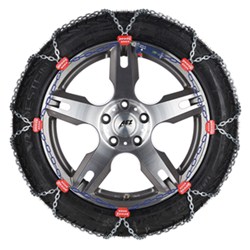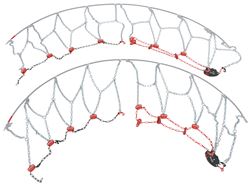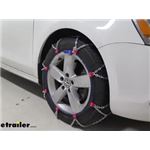
Recommended Snow chains for 2008 Jeep Grand Cherokee
Question:
I have a 2008 Jeep Grand Cherokee 4x4, stock tire size 245/65R17 and the owner’s manual says: “Install chains on rear tires only. Follow these recommendations to guard against damage and excessive tire and chain wear: • Do not install tire chains or traction devices on ve- hicles with larger than P235/65R17 tires. Tires larger than this may not provide sufficient body clearance with chains or other traction devices. • Use SAE class “S” tire chains or traction devices only.” I’m confused as to whether I can or can’t install chains on the rear given that my tire size which is stock is bigger than what is mentioned. If I can indeed install chains, which do you recommend?
asked by: Vic
Helpful Expert Reply:
From what you've mentioned, it would seem that the owner's manual is stating that chains should not be used. Typically, this is because of the limited clearance between the inside of the wheel and suspension and braking components. It couldn't hurt to check with your Jeep dealer for clarification.
If your dealer confirms that you shouldn't use chains, you have a couple of alternatives:
• Disregard their cautions and use them anyway. Many folks just do this and hope for the best. If you decide to go this route, I'd certainly use Class S-rated chains like the Pewag Snox, part # PWSXV590 and use caution when using them. Keep your speed down and make sure the chains stay tight to the tire.
• Purchase a set of inexpensive P235/65R17 tires, mount them on some salvage yard wheels and run those in the winter. When chains are needed, use an inexpensive set of Class S chains like # TC2319 from Titan chain. This would be kind of a pain, but it would allow you to use chains and still abide by Jeep's recommendations.
I've linked to some demonstration videos for the chains I mentioned above.

Products Referenced in This Question
pewag Snox Pro Tire Chains - Diamond Pattern - Square Links - Self Tensioning - 1 Pair
- Tire Chains
- Tire Chains
- Steel Square Link
- Rim Protection
- Deep Snow
- On Road Only
- Automatic
- Class S Compatible
- Drape Over Tire - No Connections
- pewag
more information >
Titan Chain Alloy Snow Tire Chains - Diamond Pattern - Square Link - 1 Pair
- Tire Chains
- Tire Chains
- Steel Square Link
- No Rim Protection
- Deep Snow
- On Road Only
- Assisted
- Class S Compatible
- Drape Over Tire - Make Connections
- Titan Chain
more information >
Product Page this Question was Asked From
pewag Servo RS Tire Chains - Diamond Pattern - Square Links - Self Tensioning - 1 Pair
- Tire Chains
- Tire Chains
- Steel Square Link
- Rim Protection
- Deep Snow
- On Road Only
- Automatic
- Class S Compatible
- Drape Over Tire - Make Connections
- pewag
more information >
Featured Help Information
Instructions
Miscellaneous Media

Continue Researching
- Q&A: Best Snow Tire Chains For 2023 Toyota RAV4 With 235/55-19 Tires
- Q&A: Best Tire Chain for 2021 Honda CRV Grand Touring with 235/55-19 Tires
- Q&A: Recommended Tire Chains For A 2024 Kia Carnival With 235/55-19 Tires
- Article: Snow Tire Chains Explained: How Tire Chains Work & When to Use Them
- Q&A: Recommended Tire Chains for 2018 Audi Q5 with 235/60R18
- Article: Snow Tire Chain Overview: How to Buy the Right Tire Chains
- Q&A: Tire Chains that Can Fit Tire Sizes 235/55R19 and 225/50R18
- Article: Pewag Snow Tire Chains
- Q&A: How Do I Measure Crossbar Spread On My Roof Rack Properly?
- Article: Best Tire Chains
- Q&A: Is There a Way to Prevent Snow Chains From Damaging Chrome Rims
- Article: Trailer Wiring Diagrams
- Article: The Definitive, Step-by-Step Flat Towing Setup Guide
- Article: My Trailer Hitch Doesn't Fit










